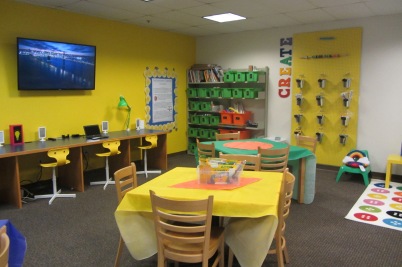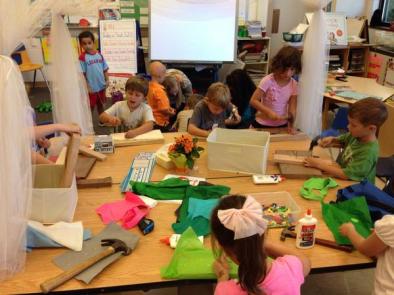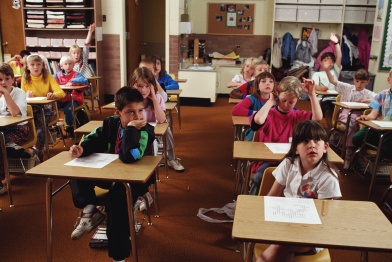This week we were asked to spend two hours researching an approach to learning. I could have chose the one I knew the best, I could have chosen the first one I typed into google, I could have even chosen the second one I typed into google. Oh wait, ya I did that. The Maker Movement sounded like something I was just going to type in, see the definition, and then forget about forever. However, the google definition that came up was “The maker movement is a social movement with an artisan spirit. Maker culture emphasizes learning-through-doing (active learning) in a social environment. Maker culture emphasizes informal, networked, peer-led, and shared learning motivated by fun and self-fulfillment (Retrieved from Wikipedia).” That sounded like crafts to me so here we are! This video can also explain it pretty well (and quickly too).
The maker movement, applied to school, can actually be called maker education. This is an approach where students work collaboratively with their hands to literally “create their learning.” I read a few articles and watched a few videos and from what I gathered, this process can be beneficial to all students. In one video, it is explained that in the regular education setting, we are not teaching students to learn, we are teaching them to comply. Students learn when they do something that matters to them to reinforce the ideas presented.
This video is super handy because it leads me to the next set of questions, what would a classroom in the maker movement look like? Well, fun fact, it would look a lot like the classrooms in that video. There would be stations for students to work with, or possibly a single space, either away, any space for making is properly titled a “makerspace.” If the video wasn’t clear enough, here’s something else.

Oh wow, this is cute and clean and quiet looking. There is only one problem, the students are missing. Any space can look like this, but let just..hold on lets put some kids in it.

Oh! There it is, and trust me, there is more stuff on the floor they purposely cropped out. When I look at this classroom I think creative juices are flowing, kids are talking, comparing, collaborating, and it will be a HUGE mess to pick up, but just think how much these kids are going to retain from this creative adventure compared to this:

When teachers use this approach, generally they will set their classrooms up into something called stations. These can be tables or even just generally accepted spaces for a station. At each station, something slightly different can be done, otherwise it is an easy way to separate students into small groups while they do hands on activities to foster their learning.
This approach is not created around every subject. It focuses on STEM, so this type of learning does not take place all day long, though it could take place throughout the day depending how subjects are split up. Honestly, personal opinion, a teacher would choose this approach if they were a skilled teacher. The results from classrooms who have implemented this are undeniable. Success of behavior troubled students is proven because they have somewhere to channel their energy. Students who would have struggled with a concept now understand them through their own findings and creations. A good teacher would at least find a way to implement this in some way or another, even if it is only at the end of a lesson or something.
There are obvious benefits as well as disadvantages to any approach. For this maker movement, pros include:
- Hands on learning
- fostered collaboration
- open ended activities
- higher order thinking and problem solving
- Emphasis on STEM
The cons:
- Resources can be expensive
- Not enough time or no time set aside
- It will take a lot of time to condition students to understand how this process should look
This is definitely something that I would want to use in my future classroom. To learn a little more about this approach in my future, I have surrounded myself with a few resources.
https://lamplightermakerspace.wordpress.com/2018/08/23/youngblood-studio-visiting-artist/

Wow, Avery! I am loving this idea of Maker movement education! I love this idea of the teacher setting up the stations and letting the kids work. I also loved your pictures of before students and then seeing them work! I wanted to join them- it looked like lots of fun and you can see that the children are learning and loving this approach to learning. I can see the positive pros to this approach of the hands on learning and the collaboration. I can also understand that it would be difficult on time and resources. Great blog and you are a great writer! 🙂 I always enjoy reading your posts! Jaime
LikeLike
Thanks, hopefully it wasn’t too long for you. I think it would be a lot of fun too!
LikeLike
Avery this is a great post! You brought such a wealth of information! The Maker movement education is so exciting to me! Of all of the things I remember from elementary school, most of them are hands on things that we literally created! This is a great approach and I really believe this is one of the best ways to get students, especially the younger ones, really engaged in their education! Being able to create is at the top of Maslow’s, so I would say evidence points to this being a great approach to learning! Great thoughts as always Avery!
LikeLike
Thanks! I had those thoughts about grade school too! I remember my science projects, art, and field trips, and that is about the extent of the learning I can recall.
LikeLike
I was going to do this one!! It sounded so cool!! I feel like we do this kind of learning a lot in teaching!! Which is so good!! Love the information you shared!! Thanks!!
LikeLike
Yes, it really was fun to learn about so I’m sure actually using it would be even better!
LikeLike
I appreciate all of the videos you included because I’ve never heard of this type of learning before. I think students should always be able to voice their ideas in the classroom. Teaching students collaboration at a young age is valuable as well.
LikeLike
I had never heard of it either, but I have decided that it’s awesome. Who doesn’t want to get all crafty and actually learn something from it?
LikeLike
Love this blog! Very organized and loved the photos! I love your choice. This is definitely my favorite type of learning as well as teaching. Junior high students especially love this type of learning!
– Katy Gottsch
LikeLike
I haven’t ever tried to implement it but I am sure at that junior high level where they are starting to feel eh about school it definitely wouldn’t hurt!
LikeLike
You did an awesome job on your blog. I think the maker movement learning looks like a lot of fun. It can get pricey and there is a lot of material that is going to be needed at times but it is very worth it. We are getting into more of the student doing their learning and not hearing about it and I think that is an awesome idea. What better way to show that they understand it then by doing it.
LikeLike
Totally! I also feel like teachers can use cheaper materials to do the same thing, sometimes we need to get a little creative to help our students be creative!
LikeLike
I feel like I would mesh well with this kind of learning. I have always been a hands on kind of person, and this maker movement sound right up my alley. Good overall summation of your learning method!
LikeLike
I am the same way, and I feel most kids learn best with their hands when they are young, thanks!
LikeLike